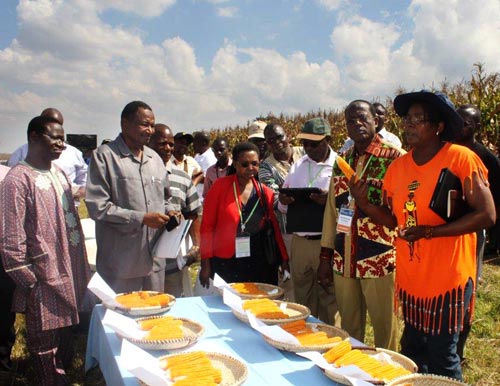CIMMYT-Southern Africa Regional Office (CIMMYT-SARO) is stepping up efforts to combat malnutrition, especially among women and children, through agricultural research and the release of orange maize varieties.
Orange maize is nutritionally enhanced and provides higher levels of vitamin A than white maize. In addition, orange maize varieties are high-yielding, disease resistant and drought tolerant, which helps farmers face challenges posed by recurrent droughts and climate change.

“Orange maize rich in beta-carotene could bring positive benefits to maize-dependent communities, particularly women and children, by providing up to half of their daily vitamin A needs,” said Thokozile Ndhlela, CIMMYT-SARO maize breeder, who is working on the orange maize breeding project. According to Ndhlela, the project is conventionally breeding non-genetically modified orange maize to endow it with higher levels of beta-carotene. Beta-carotene is a naturally occurring plant pigment that the body converts into vitamin A.
Vitamin A deficiency is a serious health threat that is prevalent in Southern Africa (SA) and may lead to blindness, reduced disease immunity and other health problems. In Zambia, for example, it affects more than half of children under five years of age, according to a Feed the Future newsletter. Feed the Future is the US Government’s global hunger and food security initiative.
In neighboring Zimbabwe, one in every three children suffers from stunted growth (as much as 32%) or chronic malnutrition, which contributes to 12,000 deaths each year, according to the United Nations Children’s Fund (UNICEF). Malnutrition is most prevalent in Zimbabwe’s rural areas, which are home to over 75% of the country’s entire population (about 13 million).
While vitamin A is available from other food sources such as oranges, dark leafy vegetables and meat, these are not always available or are too expensive for the ordinary person in SA. As a result, most people eat a lot of white maize, which has no beta-carotene.
Orange maize can be eaten as a porridge-like staple food called nshima in Zambia and sadza in Zimbabwe. It can also be used to prepare other traditional foods made from maize.
CIMMYT is working with HarvestPlus, a CGIAR organization that breeds and disseminates micronutrient-rich staple food crops to reduce hidden hunger in malnourished populations. The orange maize project was initiated in Harare, Zimbabwe, in 2004, but later moved to Mexico. Since the subtropical environments in Mexico are similar to those in SA, the germplasm developed in Mexico has adapted well to SA environments.
Three hybrids (GV662A, GV664A, and GV665A) were extensively tested in Zambia and released by the Zambia Agricultural Research Institute in partnership with HarvestPlus. These hybrids have a yield potential of 9-11 tons per hectare. Hybrid GV665A will be released in Zimbabwe in October of this year. Three seed companies are marketing the released hybrids on an exclusive basis in Zambia and four other pre-release hybrids are being tested in national performance trials.
Since 2012, HarvestPlus has provided orange maize to more than 10,000 farming households in Zambia. It is working with the private sector to reach 100,000 farmers by the end of this year.
Zimbabwe’s Crop Breeding Institute has expressed an interest in sending two of these hybrids to the Seed Certifying Authority of Zimbabwe for quality testing during the 2015/2016 agricultural season. Malawi, another SA country, has also identified hybrids for release in 2016.
 Climate adaptation and mitigation
Climate adaptation and mitigation 
